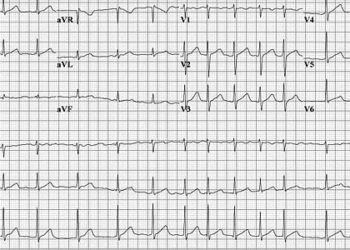Eliminating nighttime feeding decreases cardiac decline in fruit flies [PreClinical]
1. While flies subjected to time-restricted feeding (TRF) or ad libitum feeding (ALF) consumed similar total daily food quantities, TRF flies exhibited decreased age-related cardiac decline as compared to ALF flies.
2. Genetic analysis identified roles for circadian rhythm (CR) genes, the TCP-1 ring complex (TRiC) chaperonin, and components of the mitochondrial electron transport chain (ETC) in the TRF-mediated cardioprotection in older flies.
Evidence Rating Level: 3 (Average)
Study Rundown: Beyond daily schedule regulation, CRs have recently been shown to protect from disease, among other roles. The authors of this study compared flies subjected to circadian regulation of food intake (TRF group; offered food only during the first 12 hours of each 24-hour cycle) to those with unrestricted food access (ALF group).
While food intake was similar between the two groups, authors noted the TRF flies avoided weight gain, and exhibited improved flight and greater total sleep as compared to their ALF counterparts. The TRF flies also demonstrated reduced signs of age-related cardiac decline as compared to the ALF group. The cardioprotective effects of TRF were evident by some measures even when ALF flies were switched to the TRF diet later in life. TRF was also cardioprotective when both groups received a diet high in fat, which has been shown to accelerate cardiac decline. Genetic analysis revealed the TRF flies had significant up- and down-regulation of TRiC- and ETC-related genes, respectively, as compared to ALF flies. Assessment of cardiac function in flies with altered TRiC, ETC, or CR genes confirmed roles for all three in TRF-mediated cardioprotection.
While fly and human anatomies differ greatly, this work is easily translatable to human studies as it suggests health can be improved through lifestyle change rather than pharmaceutical intervention. This work prompts further study into the roles of TRiC and ETC in cardiac health.
Click to read the study in Science
Relevant Reading: Time restricted feeding without reducing caloric intake prevents metabolic diseases in mice fed a high fat diet
In-Depth [animal study]: This study examined the health, and particularly cardiac, effects of temporally restricting the diet of Drosophila melanogaster flies. Flies were divided into two groups at two weeks of age: ALF and TRF. The ALF group was maintained on the ad libitum feeding schedule, while the TRF group was restricted to a 12-hour daytime feeding period. Health metrics, including cardiac outputs, were collected at 3, 5, and 7 weeks of age. In one experiment, coconut oil was added to the normal cornmeal fly diet to examine the effects temporal restriction for flies on a high-fat diet. High-speed imaging was used to assess cardiac parameters. Classic genetic approaches were used to identify genes associated with the TRF health effects.
While 3-week-old flies were similar in both groups, 5-week old TRF flies did not exhibit the weight gain shown by ALF flies and demonstrated improved flight and increased daily sleep (n>30, p<0.05). The typical increases in diastolic interval (DI), heart period (HP) and arrhythmia index (AI; a measure of HP variability) shown in 5-week-old ALF flies were lower in TRF flies (p<0.05). Of these, only HP remained significantly lower in TRF versus ALF at 7 weeks. The decreased fractional shortening (FS; the percent difference between diastolic and systolic diameters) in ALF flies was reduced in TRF flies at 5 and 7 weeks of age (p<0.05). Flies switched from the ALF to the TRF diet at 5 weeks, or the TRF to ALF diet, exhibited cardioprotection compared to ALF flies. When both fly groups were fed a high fat diet, TRF flies displayed reduced cardiac decline.
Genetic analysis revealed TRF and ALF flies had unique amplitudes and periods of oscillating transcripts. The authors identified a cluster of TRiC genes that were upregulated in TRF flies. Flies heterozygous for each of several tested TRiC genes did not exhibit the cardioprotective effects of the TRF diet, and similar results were obtained with flies lacking one of several CR genes. These findings highlighted the importance of TRiC and the CR in TRF-mediated cardioprotection. The role of mitochondrial ETC was confirmed by individually blocking heart-specific expression of several ETC genes, which were down-regulated in TRF flies. These flies showed decreased AI and HP at 5 weeks of age on the ALF diet (n≥24).
Image: CC/
©2015 2 Minute Medicine, Inc. All rights reserved. No works may be reproduced without expressed written consent from 2 Minute Medicine, Inc. Inquire about licensing here. No article should be construed as medical advice and is not intended as such by the authors or by 2 Minute Medicine, Inc.









